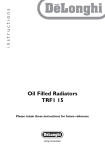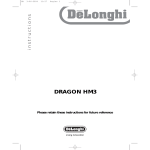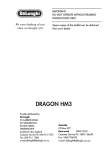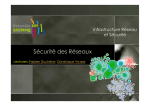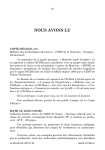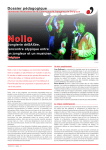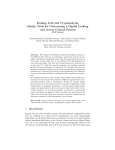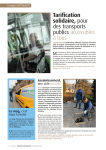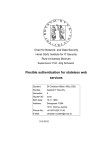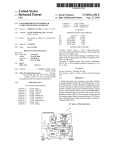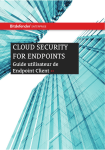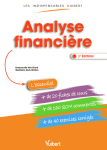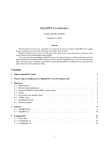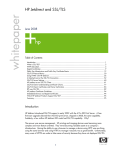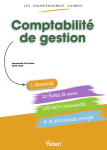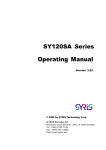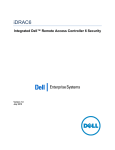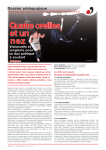Download 4 - Network security - chapters 4,5
Transcript
4MMSR 2010-2011 Grenoble INP Ensimag Sécurité des réseaux • Lecturers: Fabien Duchene, Dominique Vicard • Chapters: • 4. Intranet • 5. protocols, access Plan (nouveau, sujet à de légères modifications) o 0. Introduction o Le réseau o Parano: mode d’emploi • 4. Intranet • o 2. Qqes algorithmes o Stéganographie o Partage de secret o P2P: l’algo. Eigentrust o 3. Poste client o o o o o 2 Certifications Principes de la sécurité Principaux méchanismes NT4+ Unix Authentification • Conformance (IDS/IPS, Antimalware, NAC) • 5. Protocoles • • • • • • • • IPSec RFID RAS: PPTP, L2F, L2TP SSL/TLS VPN EAP & RADIUS 802.11 GSM 4MMSR - Network Security - 2010-2011 0.1. Introduction 6. Internet • • • Active Directory, Kerberos o 1. Menaces, vuln., attaques o Définitions o Attaques • • Pare-feu (Firewall) Proxy, Socks PKI 7. Navigateur • • • • • Privacy mode Javascript, XSS Flash, ActiveX, Java Sandbox HTLM5 4. Intranet • Authentication • Active Directory • NT5+: quelques protocoles • Kerberos • IDS & IPS • Conformance • Antimalware • Network Access Control 3 4MMSR - Network Security - 2010-2011 4.1.1. Active Directory • Active Directory Directory Services: service d’annuaire: • Ouverture de session unique • Accès universel aux ressources • Administration centralisée ou déléguée • Service d’authentification et de fourniture de données d’authentification • Fonctionnalités: • Kerberos authentication • LDAP directory (contains Security Principals & other objects) • DNS resolution • Versions: • 2000 native, 2000 mixed ; 2003, 2003 R2 ; 2008, 2008 R2 5 4MMSR - Network Security - 2010-2011 4.1.1. Rôle de machines Windows • Autonome (Workgroup) • Non membre d’un domaine • Base de comptes “SAM” (Security Account Manager) locale • Client membre (d’un domaine) • Base SAM locale • Authentification: o domaine o SAM locale • Contrôleur de domaine (DC) • Copie des objets du domaine • Assure le rôle KDC dans Kerberos o Authentifie les machines et utilisateurs 6 4MMSR - Network Security - 2010-2011 4.1.1. ADDS – Domaines, Forêts • Domaine (domain): 1 FQDN DNS, 1 annuaire (security principals, politiques de sécurité), authentification • Arbre (tree): hiérarchie de domaines DNS • Forêt (forest): plusieurs hiérarchies DNS (cf slide suivante) Tree Root domain corp.ensimag.fr jpn Domain 7 4MMSR - Network Security - 2010-2011 usa Child domain 4.1.1. ADDS – relations d’approbations • Trust relationships • “one-way trust” A<-B: one way (transitive or not) relation meaning a domain A considers the identities provided by B as valid • “two-way trust” A<->B = (A<-B) AND (B<-A) Within a tree: implicit transitive 2way trust between child and parent domains corp.ensimag.fr jpn usa Example of one-way forest trust: corp.nintendo.com trusts ms.google.biz tree domaine.phelma.fr peru “ TRUSTING domain “ 8 4MMSR - Network Security - 2010-2011 “ TRUSTED domain “ 4.1.2. Windows NT5+ : quelques protocoles • NT5: Windows 2000 • Protocoles: • clé partagés o Authentification NTLM (domaines hétérogènes) o Authentification Kerberos V5 • clé publique o Secure Sockets Layer (SSL) / transport Layer Security (TLS) o IPSec • Active Directory peut gérer différents types de credentials (SSP) • Rôles de machine Windows 11 4MMSR - Network Security - 2010-2011 4.1.3. Kerberos • Protocole authentification, autorisation, développé par le MIT (Projet ATHENA), ~ Single-Sign-On • Version actuelle: v5 RFC4120 • Hypothèse: le réseau peut être non sûr • Basé sur l’existence d’un tiers de confiance, le KDC (« Key Distribution Center » • Cryptographie • principlament symétrique • éventuellement assymétrique (eg: auth. par carte à puce) • Déclinaisons: • MIT Kerberos • Microsoft Kerberos, Windows NT (>=2000) • Heimdal Kerberos, Suède Kerberos & Herakles (Cerbère & Hercules) 12 4MMSR - Network Security - 2010-2011 4.1.3. Kerberos: authentication & service access Key Distribution Center (KDC) Identity provider, Authentication Server Ticket Grantig Service TGS GC “I am Mossen. I need a Ticket to Get Tickets” (TGT) 1 User / computer 4 2 Here is a Service Ticket containing your Here is a TGT you will only information for accessing I want to access the be able to decrypt if you “Issuing CA” service. the Issuing CA service know the shared secret Here is a proof I (user/comp. pwd) decrypted the TGT 3 5 Service Ticket UserSID ------------------------GroupMembershipsSIDs 6 Service communication 13 4MMSR - Network Security - 2010-2011 Service Server (eg: issuing CA) Introduction to the Microsoft PKI ADCS 2008 R2 (2011), Fabien Duchene, Sogeti-ESEC 4.1.3. Kerberos: authentification du client (1,2) • • • • Client_ID: Security Principal Name (username, computername…) KDC [msg]key: chiffrement de msg avec la clé key K_client: hash du mot de passe du client (user/ comp.) Knows: K_client-TGS: session key generated by the AS K_client K_TGS K_cli-TGS Identity provider, Authentication Server 1 1: Client_ID Knows: K_client 2 2.1: [Client-TGS_Session_key], K_client 2.2: “Ticket-to-Get-Ticket” [client_ID, client_FQDN, TGT_validity_period, K_client-TGS]K_TGS User / computer 14 4MMSR - Network Security - 2010-2011 4.1.3. Kerberos: autorisation d’accès au service (3,4) • TGT= [client_ID, client_FQDN, TGT_validity_period, K_client-TGS]K_TGS • • Req_svc_ID: ID of the service the client requests access to K_client-SS: session key for the client and the requested service 3 3.1: TGT, Req_svc_ID Knows: K_client K_client-TGS (K_client-SS) User / computer 15 3.2: “Authenticator” [Client_ID,timestamp]K_client-TGS KDC Knows: K_TGS (K_client-TGS) K_req_svc (K_client-SS) Ticket Grantig Service TGS 4 4.1: “Client-to-Server ticket”: [client_ID,client_FQDN,TCS_validity_period,K_client-svc] K_req_svc 4.2: [K_client-SS] K_client-TGS 4MMSR - Network Security - 2010-2011 4.1.3. Kerberos: accès au service (5,6) • Client-to-Server ticket: [client_ID,client_FQDN,TCS_validity_period,K_client-svc] K_req_svc • K_client-SS: session key between the client and the SS 5 5.1: “Client-to-Server ticket” 5.2: “Authenticator-2” [Client_ID,timestamp]K_client-SS Knows: K_client K_client-SS Service Server (eg: issuing CA) 6 6:[timestamp_in_5.2 + 1]K_client-SS : “OK, I can serve you” User / computer 16 7 Is timestamp=timestamp_5.2+1? If so, I can trust that service 4MMSR - Network Security - 2010-2011 4.1.3. Kerberos – Accès inter-domaine • Une relation de confiance est établie par le biais d’une clé partagée entre domaines, grâce à laquelle des referals tickets (TGT inter-domaine) sont envoyés “ TRUSTING domain “ contains ressources/SS “ TRUSTED domain “ contains identities corp.ensimag.fr AS domaine..phelma.fr K_AS(google)-TGS(nintendo) TGS 1 3 TGT inter-domaine 2 4 5 Service Server (eg: issuing CA) 20 4MMSR - Network Security - 2010-2011 6 User / comput er 4.1.3. Kerberos: Smart Card authentication • • • • Client_ID: Security Principal Name (username, computername…) [msg]key: chiffrement de msg avec la clé key K_client_pub,K_client_priv: paire de clé assymétrique K_client-TGS: session key generated by the AS KDC 1: [Client_ID]K_client_PRIV 1 Knows: K_client_PUB K_client_PRIV Knows: K_client_PUB K_TGS K_cli-TGS Identity provider, Authentication Server 2 2.1: [Client-TGS_Session_key], K_client_PUB 2.2: “Ticket-to-Get-Ticket” [client_ID, client_FQDN, TGT_validity_period, K_client-TGS]K_TGS User / computer 21 4MMSR - Network Security - 2010-2011 4.1.3. Kerberos et Windows: API et appels 23 4MMSR - Network Security - 2010-2011 4.1.3. Kerberos: optimisations • Optimisations • Les tickets et le clés de sessions sont en cache sur le client • Un mécanisme permet d’obtenir des tickets sans avoir à redonner son mot de passe o Ticket-Granting-Ticket (TGT) a faible durée de vie o Le KDC donne des tickets sur présentation du TGT • Paramètres par défaut • Validité TGT=10H • Validité TGS= 10H • Différence de 5 minutes MAX entre client, AS, TGS, SS synchronisation NTP 24 4MMSR - Network Security - 2010-2011 4.1.3. Kerberos – some threats and attacks • Threats • single-point of failure: if only one KDC • impersonation: if at least one KDC compromised. Any user could be impersonated • Attacks • KDC spoofing: old PAM_KRB5 implementation (no authorization) • Replay attack: sniff and resend 5. KRB_AP_REP o KRB_AP_REP: validity duration (generally 5 minutes), source IP o Service Server stores a cache of requests. Multiple identitical KRP_AP_REP are ignored • Cipher: DES (weak) initially used. Negotiation not authenticated o Windows 7: DES disabled for Kerberos authentication • Ticket cache attack (“file” on the client system) • Pass the Ticket: ability to authenticate on the client. Only Microsoft implementation is vulnerable and not yet corrected. Taming the Beast Assess Kerberos-Protected networks, Emmanuel Bouillon, Black-Hat 2009 25 4MMSR - Network Security - 2010-2011 4.2. Virtualisation (virtualization) • Mise en place d’une version virtuelle • Types: • de matériel (Hyperviseur: Hyper-V…) • de stockage, RAM,… • d’OS • de bureau, d‘application… HW virtualization – logical view • Vulnérabilités: • Rajout d’une couche supplémentaire => vulnérabilité additionnelles potentielles o Hyperviseur possède des droits système, sa compromission => compromission de l’ensemble des machines virtualisées sur le serveur 31 4MMSR - Network Security - 2010-2011 4.3. Conformité (conformance) • Définition de modèles en fonction • Du type de poste (client, serveur) • Des besoins métiers (équipe) • De la politique de sécurité • Mise en pratique des modèles • agents installés sur les postes clients et serveurs • Alerte en cas de non-conformité (monitoring/audit) 32 4MMSR - Network Security - 2010-2011 4.3.1. IDS / IPS • Intrusion Detection System: passif (enregistre, notifie) o Composant qui monitore le réseau et/ou le système o Reporte les comportements suspects ou violations de politiques • Intrusion Prevention System: detects and reacts o Actions automatiques ou semi-automatiques • Détection o Comportement statistiquement anormal (métriques?) o Signature (attack patterns) • Problèmes • Faux positifs: fausses alertes • Faux négatifs: intrusions non détectées • Position • NIDS, NIPS: Network • HIDS, HIPS: Host (server, client) 33 4MMSR - Network Security - 2010-2011 4.3.2. Antimalware • Détection • Classique: “hash du binaire” • Heuristiques (intelligence artificielle) o Signature générique: Variations légères dans le code/binaire o Comportement (exécution en sandbox ou environnement virtualisé) – Opérations (accès fichiers, configuration du système) – Différences en environnement virtualisé ou non • !! Détection non parfaite !! Cf théorie de Gödel sur l’incomplétude et l’incohérence. Problème INDECIDABLE • Configuration • • Centralisée Selon des modèles de poste (KDC, serveur web…) o o o o Exclusions (que scanner? Processus, dossiers,…) Actions (autoriser, quarantaine, supprimer, demander) Mises à jour de définitions Scans complets du système • Menaces: les antimalwares disposent de privilèges SYSTEM (iAWACS 2010) 34 4MMSR - Network Security - 2010-2011 4.3.2. Antimalware - screenshots • Exclusions • Monitoring 35 4MMSR - Network Security - 2010-2011 4.3.3. Network Acces Control • Poste client: “Accès à certaines zones” (capacité de communication avec certaines machines) en fonction: • NON de la topologie du réseau • Mais d’un ensemble de métriques du poste client o o o o Pare-feu activé? Mises à jours installées? (antimalware, OS, applications…) Chiffrement de la partition système? … • Méthodes d’isolation • DHCP, 802.1X, VPN, IPSec • Produits • Cisco NAC • Microsoft NAP (Protection) 36 4MMSR - Network Security - 2010-2011 4. Intranet summary Active Directory • Features • LDAP • DNS • Kerberos • Authentication • ACL on objects 37 Kerberos Conformance • Symetric cryptography • Single-Sign-On • Client wants to access a Service • Trusted 3rd party (KDC) • Asymetric crypto for Smart Card authenticaion • Models for computers (server, client, team, use…) • Intrusion Detection/Prevention Sys • Attack models • Undecidable problem • Antimalware • Undecidable problem • Heuristics • Network Access Control • workstation metrics • Different from topology segregation • DHCP, 802.1X, IPSec… 4MMSR - Network Security - 2010-2011 XKCD interlude: voting machines & antimalware http://xkcd.com/462/ 38 4MMSR - Network Security - 2010-2011 5. Accès - Protocoles • • • • • • • • • 40 Introduction IP, IPSec RFID RAS: PPP, PPTP, L2F, L2TP SSL/TLS VPN EAP, RADIUS 802.11/Wifi GSM 4MMSR - Network Security - 2010-2011 5.1. Introduction • Les protocoles réseaux offrent dans leur implémentations natives de nombreuses vulnérabilités • Tous les protocoles classiques disposent d’une version endurcie (hardened version) 41 4MMSR - Network Security - 2010-2011 5.1. Quelques protocoles Application HTTP FTP Telnet TCP DNS NFS Transport UDP IP ICMP Trames 42 4MMSR - Network Security - 2010-2011 5.1. Protocoles : IP, UDP et TCP (rappels) • IP : Internet Protocol (v4, v6) • UDP : User Datagram Protocol • Sans garantie d’ordre d’arrivée • Pas de retransmission • TCP : Transport Control Protocol • Connexion garantie (circuits virtuels) • Correction d’erreurs • Cf vos Cours de réseaux! 43 4MMSR - Network Security - 2010-2011 Ping Réseau Physique 5.2. IPv4 – paquet (rappel) • Un paquet IP comprend • Une charge (data) • Un Header comprenant : IP Header 44 Payload o L’adresse source IP o L’adresse destination IP 4MMSR - Network Security - 2010-2011 5.2. IPSec – extension de IPv4 • Sécurisation de IPv4: • RFC 2401 : IP Security Architecture • RFC 2402 : IP Authentication Header (AH) • RFC 2406 : IP Encapsulating Security Payload (ESP) • RFC 2408 : Internet Security Associations and Key Management Protocol (ISAKMP) • IPv6 inclus IPsec! • Cf vos Cours de réseaux! 45 4MMSR - Network Security - 2010-2011 5.2. IPSec – integrity, authentication, encryption • AH (51st IP protocol) • Authentication, integrity, anti-replay • NO CONFIDENTIALITY • integrity on PAYLOAD and IP header o problems with Network Address Translation (Network lectures) • ESP (50th IP protocol) • Authentication, integrity, anti-replay • PAYLOAD CONFIDENTIALITY • IP header unchanged only in tunnel mode • NAT-Transversal • Usages: AH, ESP or AH+ESP Formation DirectAccess, Youssef Zizi & Cyril Voisin, Microsoft (2010) 47 4MMSR - Network Security - 2010-2011 5.2. IPSec Authentication Header (AH) Original IP Header IP payload • Transport mode Original IP Header AH header IP payload authenticated / integrity • Tunnel mode New IP Header AH header Original IP Header IP payload authenticated / integrity • Integrity: hash covering the whole datagram, except • TypeOfService, Fragment Offset, Flags, TTL, IP header checksum Formation DirectAccess, Youssef Zizi & Cyril Voisin, Microsoft (2010) 48 4MMSR - Network Security - 2010-2011 5.2. IPSec Encapsulating Security Payload (ESP) • Transport mode Original IP Header ESP header IP payload ESP Trailer ESP Auth encrypted Authenticated / integrity • Tunnel mode ESP New IP Header header Original IP Header IP payload ESP Trailer ESP Auth encrypted Authenticated / integrity • IP header NOT protected Formation DirectAccess, Youssef Zizi & Cyril Voisin, Microsoft (2010) 49 4MMSR - Network Security - 2010-2011 5.2. IPSec – SA & IKE • SA : Security Association • Décrit comment seront utilisés les services de sécurité lors d’un échange o L’algorithme de chiffrement utilisé o L’algorithme d’authentification utilisé o Une clé de session partagée (donc symétrique, pour raison de performance) • unidirectionnel • lie des adresses IP Vue des SA dans le pare-feu Windows (NT6+, Vista et ultérieur) • IKE : Internet Key Exchange • Distribution des clés 52 4MMSR - Network Security - 2010-2011 5.2. IPSec en entreprise 53 4MMSR - Network Security - 2010-2011 5.3. Radio Frequency IDentification “RFID” • Reader + tag(s) • tag ; two main types: • only replies its ID (cleartext, without reader authentication nor data encryption) • can perform cryptographic operations • Applications: Tracking (Passport, goods), Access control • Security issues: • Privacy (eg: chip inside hand, contactless) • Vulnerabilities: o Replay attacks (if no cryptoprocessor) o Wireless, thus antenna range (amplification..) => privacy o The ID is generally used within a web application (thus classic web attacks (SQL injection, XSS…)) => check your Conceiving Web-App lectures 54 4MMSR - Network Security - 2010-2011 5.4. Remote Access Server « RAS » • Permits a remote access to IP and IPX networks • May eventually require a Call-Back 1 RAS server Access Point PPP connection initialization 2 the AP requests a PAP, CHAP or EAP authentication 3 the user authenticates 4 the RAS server connects to the network (eg: PPTP,L2F,L2TP) User / computer 4 … connects to itself only 4 … rejects the connection (authorization or authentication fails) 4 55 Network requests a call-back 4MMSR - Network Security - 2010-2011 5.4.1. Point-to-Point Protocol “PPP” • Data link protocol for a communication between two nodes “Point-to-Point connection” • Authentication, encryption, compression FTP • Connection to a Remote Access Server Application SMTP DNS ; … HTTP … Transport • PPP: dialup ; PPPoE & PPPoA : DSL TCP Internet UDP IP ; IPv6 PPP Network access • RFC: http://tools.ietf.org/html/rfc1661 • PPP packet: PPP header 56 4MMSR - Network Security - 2010-2011 PPPoE PPPoA Ethernet ATM PPP payload L2 (eg: IP) L3 (eg: TCP) L3 payload header header 5.4.2. RAS Authentication methods • PAP (Password Authentication Protocol) • unencrypted ASCII password ! • CHAP (Challenge Handshake AP) • Shared secret key (eg: user password) • Periodically a challenge is sent to the client • Response: hash(challenge,secret_key) • EAP (Extensible AP) • several authentication methods o EAP-TLS 58 4MMSR - Network Security - 2010-2011 5.4.3. Tunnel protocols: PPTP • PPTP : Point-to-Point Tunelling Protocol • Microsoft (& Alcatel-Lucent, 3Com) • PPP link over IP ONLY o GRE Generic Routine Encryption tunnel encapsulating PPP packets o Control channel over TCP 1723 • permits confidentiality, integrity and authentication PPTP packet PPP packet IP Header GRE Header PPP header PPP payload (IP / IPX datagram) encrypted 59 4MMSR - Network Security - 2010-2011 5.4.3. PPTP data flow 60 4MMSR - Network Security - 2010-2011 5.4.3. Tunnel protocols: L2F, L2TP • These ones have no encryption capabilities • Necessary to use an additional protocol (eg: IPSec) • L2F : Layer 2 Forwarding protocol • Cisco, 1998 RFC2341 • UDP 1701 IP UDP L2F PPP Packet • L2TP : Layer 2 Tunelling Protocol • 1999, Cisco & Microsoft RFC2661, L2TPv3 2005 RFC3931 • Not necessarily over an IP network ; does support RADIUS L2TP data channel 61 Transport (unreliable) (UDP, ATM…) L2TP control channel 4MMSR - Network Security - 2010-2011 (reliable) L2TP data msg L2TP control msg PPP Packet 5.5. Secure Socket Layer “SSL” / TLS • SSL 1.0: Netscape, 1995 ; TLS = Transport Security Layer • Current version: TLS 1.2 (aka SSL 3.3), RFC5248 aug 2008 • Security properties Application o Communication: – Integrity (MAC) – Confidentiality (symmetric cryptography) HTTP, FTP, SIP, IMAP, POP… o Server: authentication (asymetric crypto) o Key exchange (RSA, Diffie-Hellman…) o Eventually client authentication SSL/TLS TCP • Sub-protocols 63 o Handshake: version, algorithm, authentication o Record: data fragmentation (app. layer), integrity, confidentiality o Alert: errors, end of session o ChangeCipherSpec: messages will be authenticated (and eventually encrypted) Application: 4MMSR - o Network Security - 2010-2011 application data 5.5. SSL handshake (unauthenticated client) MAC = Message Authentication Code ; hash_function(key, message) 1.1 ClientHello (ciphers and compression it supports, ClientNonce) Cipher and compression choice 1.2 1.3.1. ServerHello (chosen TLS version, cipher, compression, and a ServerNonce) 1.3.2. Certificate 1.3 1.3.3. ServerHelloDone 1.4 ServerCertificate validation (integrity, validity time, revocation) 1.5 ClientKeyExchange (PreMasterSecret encrypted using K_server_pub) Eventually sends the serverNonce encrypted with K_client_priv Decryption of the PreMasterSecret (using K_Server_priv) 1.6 1.7 Session_keys = function(PreMasterKey,ClientNonce,ServerNonce) 1.7 Client 1.8 1.8.1. ChangeCipherSec (next messages will be authenticated and encrypted) 1.8.2. Finished = hash(prev_msgs) ; MAC(session_key, prev_msgs) 1.9.1. ChangeCipherSec 1.9.2. Finished = hash(prev_msgs) ; MAC(session_key, prev_msgs) 65 Server 4MMSR - Network Security - 2010-2011 1.9 5.6. Virtual Private Network (VPN) • Réseau Privé Virtuel • Private (confidential) tunnel over a public network • Interconnecting with remote office • Connecting to the corporate network when outside • Protocols • PPTP, L2TP/IPSec • HTTPS • Risks • “the Internet can access inside the corporate network” o strong authentication (at least 2 factors) o operational network teams, security teams 68 4MMSR - Network Security - 2010-2011 5.7. 802.1X, EAP, RADIUS • EAP, authentication framework RFC5247 • Used in 802.1X, PPP ; could use RADIUS for authorization 802.1X supplicant EAP Peer EAPOL-start 802.1 X authenticator RADIUS client EAP-request/identity EAP-response/identity EAP-request EAP-success PPP 4MMSR - Network Security - 2010-2011 RADIUS-access-request (EAP) RADIUS-access-accept (EAP) TLS IP 802.3 EAP PSK … EAPOL 802.1X IKEv2 802.11 … 73 RADIUS-access-request (EAP) RADIUS-access-challenge (EAP) EAP-response (credentials) modem 802.1 X authentication server RADIUS server shared secret key Corporate ressources controlled port If authentication or authorization error: RADIUS-access-reject (EAP) RADIUS EAP … IP… 5.8. 802.11 - Wifi • 802.11 security • 802.11 • RC4 • WEP • SKA • WPA • 802.11i • WPA2 • 802.11 security in corporations 75 4MMSR - Network Security - 2010-2011 5.8.1. 802.11 • 802.11: a (1999), b(1999), g(2003), n (2009) • Review your network courses • Security (1999): • Data encryption: Wireless Equivalent Privacy “WEP” • Authentication: o Shared Key Authentication “SKA” (WEP is used during authentication) o Open System Authentication (no authentication occurs) 76 4MMSR - Network Security - 2010-2011 5.8.1. Reminder: RC4 • stream cipher • IV: Initialisation Vector • Key (shared between the parties) Wikipedia-WEP • Flaws: • if the same IV is used, same as one-time pad! • if number generator weak, ability to gain some knowledge about the key Weaknesses in the Key Scheduling Algorithm of RC4, Scott Fluhrer, Itsik Mantin, Adi Shamir 78 4MMSR - Network Security - 2010-2011 5.8.1. Wireless Equivalent Privacy "WEP" • Chiffre = RC4 – 56 bits • IV : 24 bits • 802.11 does not prevent reusing the same IV!! • Key = “WEP password” • 40 bits (40+24= “64 bits WEP security”) • 104 bits (“128 bits WEP security”) • ICV : Integrity Check Value : CRC-32 79 • clear-text frame: 802.11 header 802.11 payload • WEP-encrypted frame: 802.11 header IV 4MMSR - Network Security - 2010-2011 Encrypted data ICV Chiffré 5.8.1. Shared Key Authentication “SKA” • Four Way Handshake using the WEP password (secret key) Client station 1 Access Point Authentication-request clear-text challenge 3 shared secret key (WEP password) RAC4(challenge, WEP key) Challenge decryption and comparison Positive / negative response 80 2 --- shared secret key (WEP password) 4 4MMSR - Network Security - 2010-2011 5.8.1. RC4 problem – Vernam cipher • if real randomness, then one-time pad Secret Key KE Pseudo Random Number Generator Random number r Unencrypted data d XOR • What if r is not so random?... 82 4MMSR - Network Security - 2010-2011 Encrypted data e = d XOR r 5.8.1. Stream cipher: basic cryptanalysis • What if the same encryption key is used at least two times? • e1=d1 XOR r • e2=d2 XOR r • Then: e1 XOR e2 = d1 XOR d2 • From that we can deduce: • reusing r is a VERY bad idea • d1 and d2 are not random (thus sensible to “patterns attacks”. See aircrack (ARP attacks)) • 802.11 o ICV (CRC) could confirm we did find the value! o “r” is IV+wep_password 83 4MMSR - Network Security - 2010-2011 5.8.1. the Birthday paradox with 802.11 IVs • Pn: probability that 2 packets among n do use the same IV • IV: 24 bits ; thus number of IV = 2^24 • P2 = 1/(2^24) • Pn = Pn–1 + (n – 1)(1 – Pn–1)/(2^24) (n>2) • Pn >= 50% • Starting from only n=4823 packets! 84 4MMSR - Network Security - 2010-2011 5.8.1. WEP security? • Attacking WEP only takes ~ 3 minutes • aircrack-ng (original work, Christophe Devine) • Consequences • Ability to modify the packets (integrity loss) • Ability to authenticate • Solutions • increasing the size of the WEP key (and/or the possible space of the IV) is not enough (B’day paradox) • authentication, we could use EAP (see 802.11 WPA2) • we should rely on another kind of cipher (eg: block cipher, see WPA) 87 4MMSR - Network Security - 2010-2011 5.8.2. Wifi Protected Access “WPA” • Intermediate measures to protect Wifi networks while waiting for full 802.11i specs (aka WPA2) • 2002 • without changing the hardware! (only require a ram flash) • Authentication and integrity • Temporary Key Integrity Protocol (TKIP) o still RC4 but: 128 bits key/packet o rekeying mechanism (frequently change, avoiding collisions) o the ICV field is replaced by – a MICHAEL integrity check (64 bits) – sequence number for each packet (replay protection) • AES (block cipher), optionnal o Mandatory in WPA2 90 4MMSR - Network Security - 2010-2011 5.8.2. WPA (with TKIP) attacks 91 • En novembre 2008 deux chercheurs allemands en sécurité, Éric Tews et Martin Beck, ont annoncé avoir découvert une faille de sécurité dans le protocole WPA. La faille, située au niveau de l'algorithme TKIP (Temporal Key Integrity Protocol), exploite l'architecture du protocole WPA. • TKIP se met en place après le protocole WEP, or le code MAC est contenu dans un paquet WEP, ce qui permet à un pirate informatique de l'intercepter. Une fois intercepté le paquet peut être utilisé pour récupérer le code MAC et se faire passer pour le point d'accès. Cette méthode est encore plus efficace en interceptant les paquets ARP puisque leur contenu est connu. (attaques par pattern).Cette faille concerne exclusivement le protocole WPA utilisant TKIP. Les protocoles utilisant AES restent sécurisés. • Les détails concernant cette faille ont été exposés de façon détaillée durant la conférence PacSec les 12 et 13 novembre 2008 à Tokyo[2]. Martin Beck a intégré l'outil pour exploiter cette faille dans son outil de piratage des liaisons sans fil, nommé aircrack-ng (createur originel d’aircrack: Christophe Devine). • Contre-mesure: Il est toutefois assez facile de contrevenir à cette faille en forçant la négociation des clés toutes les deux minutes ce qui ne laisse pas assez de temps pour que l'attaque réussisse. 4MMSR - Network Security - 2010-2011 5.8.3. 802.11i • IEEE standard: 802.11-2007 (draft in 2004, amended in 2007) • WPA2 • CCMP (Counter-Mode/CipherBlockChaining-Mac Protocol) o AES/FIPS-197 o 128-bit key, 128 bits cipher block o 10 rounds of encoding • 802.1x support in 802.11 • Key distribution 92 4MMSR - Network Security - 2010-2011 5.8.4. 802.11 in corporations • WPA-enterprise • WPA2-enterprise • EAP for authentication and encryption. Mostly used • EAP-TLS (with certificates, thus a PKI is needed) • EAP-TTLS • PEAP (Microsoft) 93 4MMSR - Network Security - 2010-2011 5.9. GSM • 5 billion users • For the basics, review your 1st year GSM course • Main security services • Subscriber authentication • Data and signalization confidentiality • Subcriber identity confidentiality / (privacy) 94 4MMSR - Network Security - 2010-2011 5.9. GSM security – global view Subscriber - Le triplet (RAND,SRES,Kc) est passé d’un réseau à l’autre - A5, algorithme de chiffrement, n’est toujours pas officiellement public (A5/1, A5/3) - A3 + A8 est connu sous le nom de A38 96 4MMSR - Network Security - 2010-2011 5.9. GSM security – subscriber authentication - Le réseau envoit un challenge RAND - L’abonné possède une clé secrète Ki - Stockée dans la carte SIM et dans l’AUC (Centre d’authentification) - L’authentification sert à générer une clé Kc de chiffrement des données et de la signalisation - A3: one-way hash paramétré par clé 98 4MMSR - Network Security - 2010-2011 5.9. GSM security – data and signalization confidentiality - A8 - Le réseau et le mobile - Kc=A8(Ki,RAND) - One-way hash paramétrée par clé - A5=symetric stream cipher (specs secrètes) - chiffre les données et la signalisation - A5/1 (initially USA+Europe) - A5/2 (initially others) - A5/3 (should be used everywhere…) 100 4MMSR - Network Security - 2010-2011 5.9. GSM security – protecting the subscriber identity • Identification de l’abonné (MS): seul le numéro est connu • IMSI : Identité invariante de l’abonné : est gardée secrète à l’intérieur du réseau • TMSI : Identité temporaire, attribuée après une authentification réussie • MSISDN : Numéro de l’abonné : c’est le seul identifiant de l’abonné mobile connu à l’extérieur du réseau GSM • MSRN : Numéro attribué lors d’un appel, pour l’acheminement des données 101 4MMSR - Network Security - 2010-2011 5.9. GSM security – protecting the subscriber identity Note : • VLR : Visitor Location Register : registre de la cellule ou se trouve le mobile • HLR : Home Location Register : registre de l’opérateur du mobile • VMSC : Visitor Mobile Service Switching Center : établissement, hand-over et SMS • GSMC : Gateway SMC 102 4MMSR - Network Security - 2010-2011 5.9. GSM security – subscriber privacy • Frequency-Hopping Speard Spectrum (FHSS) • Rapidly switching of carrier among many channels • Using a pseudorandomness function • Usage • Mainly for QoS • .. But could and SHOULD be used for user privacy! 103 4MMSR - Network Security - 2010-2011 5.9 attacking the wideband GSM network • Cryptosystem • “A5/1 could be cracked in seconds” GSM SRLSY? Karsten Nohl, 26C3 (2010) o 2To rainbow tables (…available on Bittorrent) o … for less than $1.000 H/W! Wideband GSM Sniffing, Karsten Nohl, Sylvain Munaut, 27C3 (2011) • A5/3 o A practical-Time attack on the A5/3 Cryptosystem Used in 3G telephony, Orr Dunkelman, Nathan Keller et Adi Shamir (2010) o 75% probability with 1Go of data. ~ 2H communication. (seems unpractical) o However, since multimedia usage do proliferate… • …And in practise: • • • • 105 Unfrequent TMSI changes Unfrequent Hopping No systematic rekeying before each call or SMS Predictable padding => confidentiality threatened!! 4MMSR - Network Security - 2010-2011 5.9. GSM security in 2011… Wideband GSM Sniffing, Karsten Nohl, Sylvain Munaut, 27C3 (2011) 106 4MMSR - Network Security - 2010-2011 5. Protocols, access summary 107 IPSec EAP VPN •Useful for VPN and for internal network •Modes: transport, tunnel •AH, ESP, IKE, SA •Authentication framework •802.1X, RADIUS, WPA(2)-enterprise •Encrypted tunnel over a public network •IPSec, L2TP/IPSec, L2F, HTTPS SSL/TLS 802.11 GSM •Btwn transport and application layer •Certificate (server, eventually client) •handshake •WEP: RC4 stream cipher •WPA: adds TKIP, not enough •WPA2: AES block cipher •Corporations: WPA(2)-enterprise ; mostly EAP-TLS •TMSI: temporary identity •Hopping: mainly for QoS (could be for privacy) •Rekeying each time the user authenticate •A5/1, A5/2: should not be used (real-time attacks) 4MMSR - Network Security - 2010-2011 Interlude 108 4MMSR - Network Security - 2010-2011




































